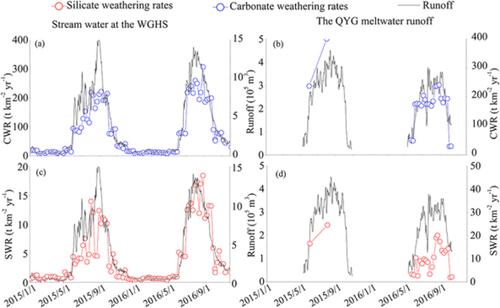当前位置:
X-MOL 学术
›
Hydrol. Process.
›
论文详情
Our official English website, www.x-mol.net, welcomes your
feedback! (Note: you will need to create a separate account there.)
Chemical weathering and CO2 consumption in the glaciated Karuxung River catchment, Tibetan Plateau
Hydrological Processes ( IF 2.8 ) Pub Date : 2021-08-01 , DOI: 10.1002/hyp.14330 Fan Zhang 1, 2 , Xiong Xiao 3 , Lijie Wang 1 , Chen Zeng 1 , Zhengliang Yu 1 , Guanxing Wang 1 , Xiaonan Shi 1
Hydrological Processes ( IF 2.8 ) Pub Date : 2021-08-01 , DOI: 10.1002/hyp.14330 Fan Zhang 1, 2 , Xiong Xiao 3 , Lijie Wang 1 , Chen Zeng 1 , Zhengliang Yu 1 , Guanxing Wang 1 , Xiaonan Shi 1
Affiliation

|
Climate factors play critical roles in controlling chemical weathering, while chemically weathered surface material can regulate climate change. To estimate global chemical weathering fluxes and CO2 balance, it is important to identify the characteristics and driving factors of chemical weathering and CO2 consumption on the Tibetan Plateau, especially in glaciated catchments. The analysis of the hydro-geochemical data indicated that silicate weathering in this area was inhibited by low temperatures, while carbonate weathering was promoted by the abundant clastic rocks with fresh surfaces produced by glacial action. Carbonate weathering dominated the riverine solute generation (with a contribution of 58%, 51%, and 43% at the QiangYong Glacier (QYG), the WengGuo Hydrological Station (WGHS), and the lake estuary (LE), respectively). The oxidation of pyrite contributed to 35%, 42%, and 30% of the riverine solutes, while silicate weathering contributed to 5%, 6%, and 26% of the riverine solutes at the QYG, WGHS, and LE, respectively. The alluvial deposit of easily weathering fine silicate minerals, the higher air temperature, plant density, and soil thickness at the downstream LE in comparison to upstream and midstream may lead to longer contact time between pore water and mineral materials, thus enhancing the silicate weathering. Because of the involvement of sulfuric acid produced by the oxidation of pyrite, carbonate weathering in the upstream and midstream did not consume atmospheric CO2, resulting in the high rate of carbonate weathering (73.9 and 75.6 t km−2 yr−1, respectively, in maximum) and potential net release of CO2 (with an upper constraint of 35.6 and 35.2 t km−2 yr−1, respectively) at the QYG and WGHS. The above results indicate the potential of the glaciated area of the Tibetan Plateau with pyrite deposits being a substantial natural carbon source, which deserves further investigation.
中文翻译:

青藏高原卡鲁松河流域冰川化学风化与CO2消耗
气候因素在控制化学风化方面起着关键作用,而化学风化的表面材料可以调节气候变化。为了估计全球化学风化通量和 CO 2平衡,确定化学风化和 CO 2的特征和驱动因素很重要青藏高原的消费,特别是在冰川集水区。水文地球化学资料分析表明,该区的硅酸盐风化受低温抑制,而碳酸盐风化则受冰川作用产生的大量新鲜表层碎屑岩的促进。碳酸盐风化在河流溶质生成中占主导地位(在强雍冰川(QYG)、翁果水文站(WGHS)和湖口(LE)分别贡献了 58%、51% 和 43%)。黄铁矿氧化贡献了 35%、42% 和 30% 的河流溶质,而硅酸盐风化对 QYG、WGHS 和 LE 的河流溶质的贡献分别为 5%、6% 和 26%。易风化的细硅酸盐矿物的冲积矿床,较高的气温,植物密度,与上游和中游相比,下游 LE 的土壤厚度和土壤厚度可能导致孔隙水和矿物材料之间的接触时间更长,从而增强硅酸盐风化。由于黄铁矿氧化产生的硫酸的参与,上中游碳酸盐风化不消耗大气CO2,导致碳酸盐风化速率高(最大分别为73.9 和 75.6 t km -2 yr -1)和潜在的 CO 2净释放(上限为 35.6 和 35.2 t km -2 yr -1,分别)在 QYG 和 WGHS。上述结果表明,青藏高原冰川区黄铁矿矿床具有重要的天然碳源潜力,值得进一步研究。
更新日期:2021-08-20
中文翻译:

青藏高原卡鲁松河流域冰川化学风化与CO2消耗
气候因素在控制化学风化方面起着关键作用,而化学风化的表面材料可以调节气候变化。为了估计全球化学风化通量和 CO 2平衡,确定化学风化和 CO 2的特征和驱动因素很重要青藏高原的消费,特别是在冰川集水区。水文地球化学资料分析表明,该区的硅酸盐风化受低温抑制,而碳酸盐风化则受冰川作用产生的大量新鲜表层碎屑岩的促进。碳酸盐风化在河流溶质生成中占主导地位(在强雍冰川(QYG)、翁果水文站(WGHS)和湖口(LE)分别贡献了 58%、51% 和 43%)。黄铁矿氧化贡献了 35%、42% 和 30% 的河流溶质,而硅酸盐风化对 QYG、WGHS 和 LE 的河流溶质的贡献分别为 5%、6% 和 26%。易风化的细硅酸盐矿物的冲积矿床,较高的气温,植物密度,与上游和中游相比,下游 LE 的土壤厚度和土壤厚度可能导致孔隙水和矿物材料之间的接触时间更长,从而增强硅酸盐风化。由于黄铁矿氧化产生的硫酸的参与,上中游碳酸盐风化不消耗大气CO2,导致碳酸盐风化速率高(最大分别为73.9 和 75.6 t km -2 yr -1)和潜在的 CO 2净释放(上限为 35.6 和 35.2 t km -2 yr -1,分别)在 QYG 和 WGHS。上述结果表明,青藏高原冰川区黄铁矿矿床具有重要的天然碳源潜力,值得进一步研究。











































 京公网安备 11010802027423号
京公网安备 11010802027423号